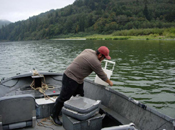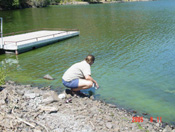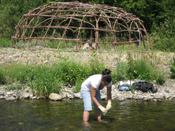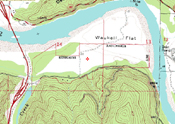Tribal Water Quality Plans
Tribes have unique authority to manage and protect water quality within their Reservations, including the establishment of water quality control plans listed below. Also, tribes may apply to the U.S. Environmental Protection Agency under the Clean Water Act (CWA) for official designation as co-managing water quality authorities. Tribes in the lower Klamath Basin have water quality specialists on staff within environmental protection or natural resource departments.
Text blocks below citations are excerpts.
Yurok Tribe Environmental Program. 2004 Water Quality Control Plan For the Yurok Indian Reservation. Yurok Tribe Environmental Program, Klamath, CA. 41 p.
The primary responsibility for the protection of the water quality on the Yurok Indian Reservation (YIR) has been assigned to the Yurok Tribal Environmental Program (YTEP) and the Fisheries Program (YTFP). YTEP and YTFP provide YIR wide coordination of the water quality control program by developing, reviewing, and recommending Tribal (Yurok Tribe) approval of Reservation-wide policies, plans and permits for the implementation of Tribal and federal law.
The water quality standards outlined in this document and its subsequent amendments are designed to fully protect the beneficial uses of Reservation waters.....As a sovereign power recognized by the Federal Government, a co-manager of natural resources, and by the U.S. Environmental Protection Agency (U.S. EPA) for purposes of water pollution control, the Tribe maintains jurisdiction over waters that flow into and through the Reservation, regardless of the geographic origins of water sources.
Hoopa Valley Tribe Environmental Protection Agency (HVTEPA). 2020. Water Quality Control Plan Hoopa Valley Indian Reservation. Approved September 11, 2002, Amendments Approved May 29 2020. Hoopa Tribal EPA. Hoopa, CA. 115 p.
The Hoopa Valley Tribe applied for treatment as a state with respect to the Water Pollution Control Program under Section 106 of the Clean Water Act (CWA) on July 16, 1989. The United States Environmental Protection Agency (EPA) announced formal approval of the application on July 3, 1990. Upon receiving approval, the Hoopa Valley Tribe became the first tribe in the State of California to receive such approval.
The Hoopa Valley Tribal Council adopts the Water Quality Control Plan, which consists of water quality criteria, standards, anti-degradation policy, and implementation plans, in accordance with the Pollutant Discharge Prohibition Ordinance (PDPO), which declares that protection of the quality of surface and ground waters for the use and enjoyment by the people of the Hoopa Tribe requires control of the discharge of waste to waters of the Reservation. It is the intent of the Tribal Council, in adopting the WQCP that the Forest Management Plan, the PDPO, Riparian Protection and Surface Mining Ordinance, and other Plans and Ordinances developed to improve the waters of the Reservation will be used as anti-degradation policies. These Tribal regulatory documents are to be used as the mechanism to identify the actions needed to protect surface and ground waters of the Reservation.
Karuk Tribe of California. 2014. Water Quality Control Plan. Karuk Tribe Department of Natural Resources, Orleans, CA. 45 p.
The need for comprehensive water quality planning is set forth in Karuk Tribe of California (KTOC) laws under Resolution 96-R-24. The Federal Water Pollution Control Act as amended by the Clean Water Act of 1977 require water quality control plans for the waters of tribes as well as public review of the plans. The basic purpose of KTOC’s planning effort is to determine the future direction of water quality control for protection of Tribal waters.
The Water Quality Control Plan is comprehensive in scope. It contains a brief description of Tribal trust property located along the middle portion of the Klamath River, and describes the present and potential beneficial uses of the surface and ground waters. The water quality objectives contained in the report are prescribed for the purposes of protecting the beneficial uses. The implementation plans section describes the measures, which include specific prohibitions, action plans, and policies which form the basis for the control of water quality.
Tribal plans and enforcement mechanisms are included. The report contains provisions for public participation, complies with the requirements of CWA Section 303, and establishes a setting and the framework for the development of discharger regulations.
See also: Karuk Tribe Department of Natural Resources. 2006. Eco-Cultural Resources Management Plan. Karuk DNR, Orleans, CA. 76 p. (908 Kb)
Quartz Valley Indian Reservation. 2009. Water Quality Monitoring and Assessment Report 2008. By Crystal Bowman, Environmental Director, QVIR, Fort Jones, CA. 65 p.
Quartz Valley Indian Reservation. 2008. Water Quality Monitoring and Assessment Report 2007. By Crystal Bowman, Environmental Director, QVIR, Fort Jones, CA. 59 p.
The Quart Valley Indian Reservation (QVIR) Environmental Protection Department (EPD) began the process of developing a Water Pollution Control Program in accordance with the Clean Water Act (CWA) in 2005. The Tribe set primary goals of ensuring salmonid spawning and rearing habitat, fishing, swimming, other wildlife habitat and cultural needs. The objective is to ensure these goals are met for the future protection and sustained use of valuable Reservation water resources, protection of public health and welfare, and the enhancement of water quality resources. The Tribe intends to protect and improve water resources through water quality monitoring, habitat evaluation, education and community outreach, planning and implementation.
Resighini Rancheria Environmental Protection Authority. 2006. The Resighini Rancheria Tribal Water Quality Ordinance Number 01-2002. Resighini Rancheria, Klamath, CA. (441 Kb)"
Since time immemorial, the Klamath River, Waukell Creek and the numerous other unnamed creeks, streams, ponds, springs and their tributary streams, the streambeds thereof and the riparian areas adjacent thereto, have been natural resources of profound significance to the Yurok People who have used these resources for cultural, ceremonial, religious, fishery, seasonal residential and other purposes fundamental to the Tribe’s way of life.
The members of the Resighini Rancheria have a primary interest in the protection, control and conservation of the water resources which flow into and through the Rancheria, and the quality of such waters must be protected to insure the health, economic, aesthetic and cultural well-being of the people of the Rancheria.








